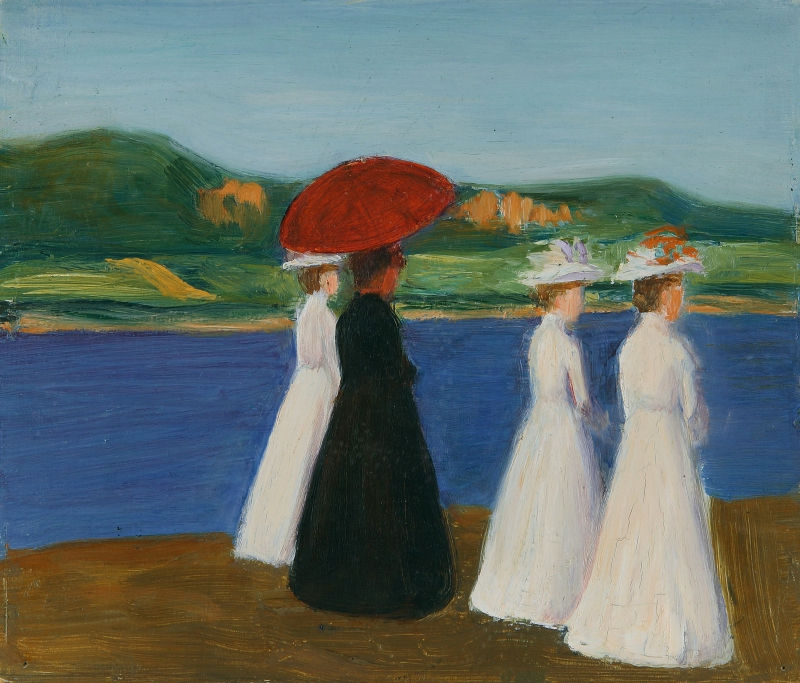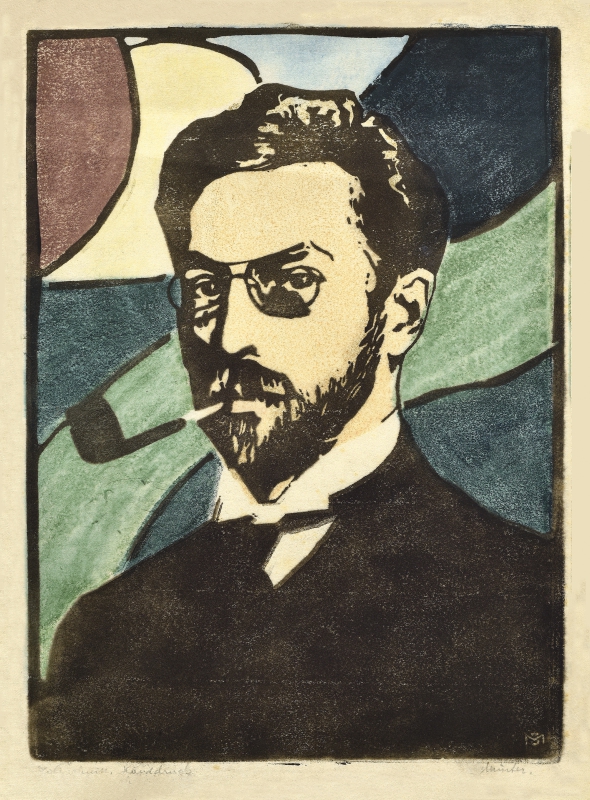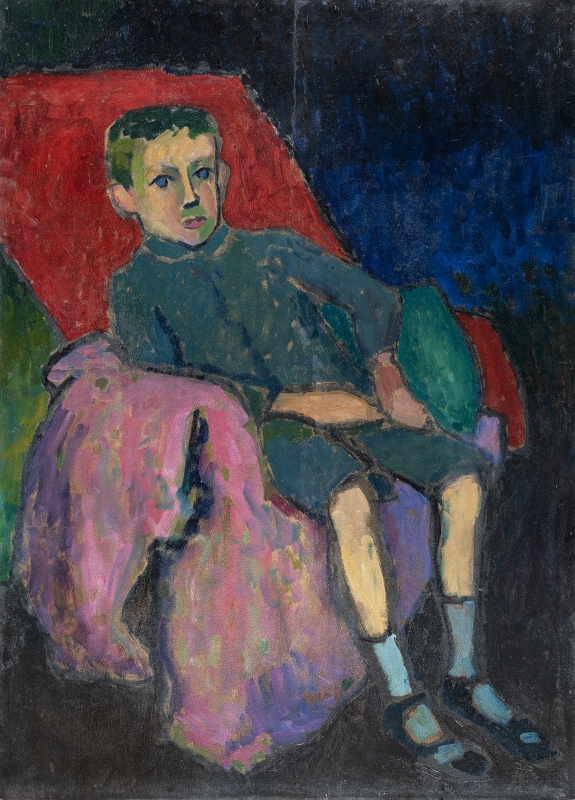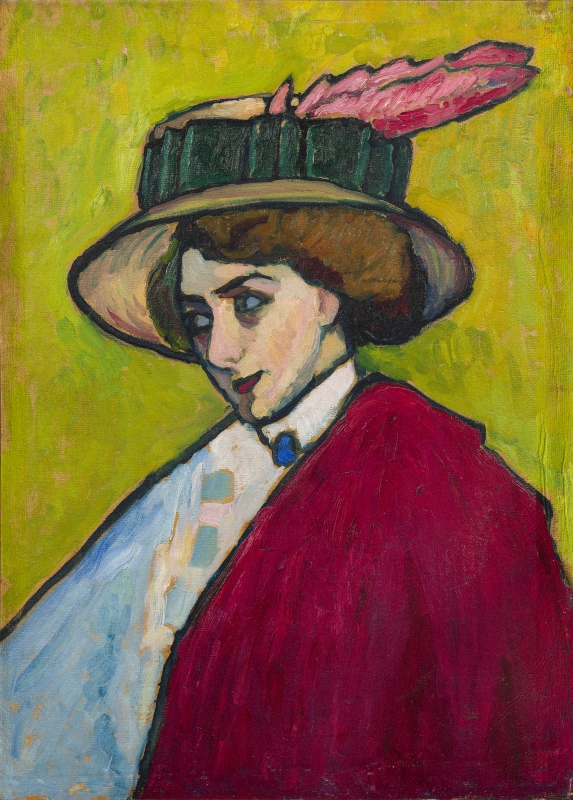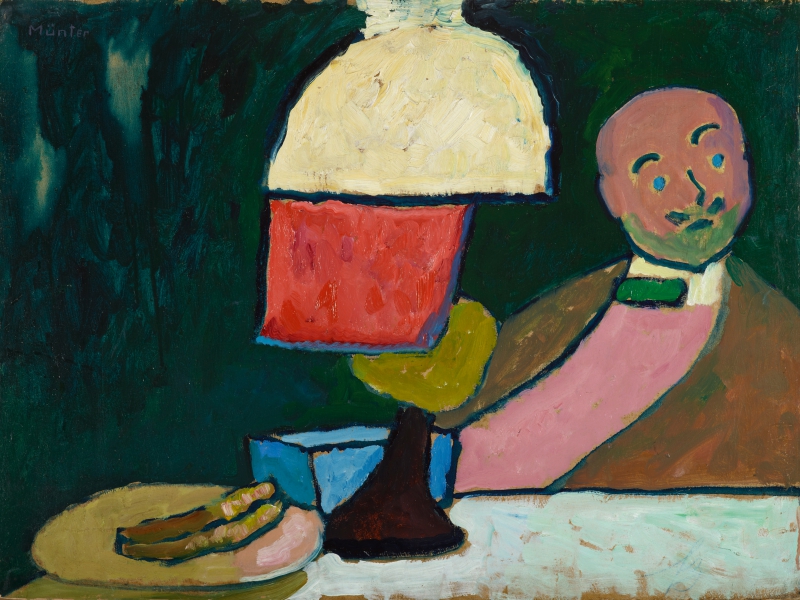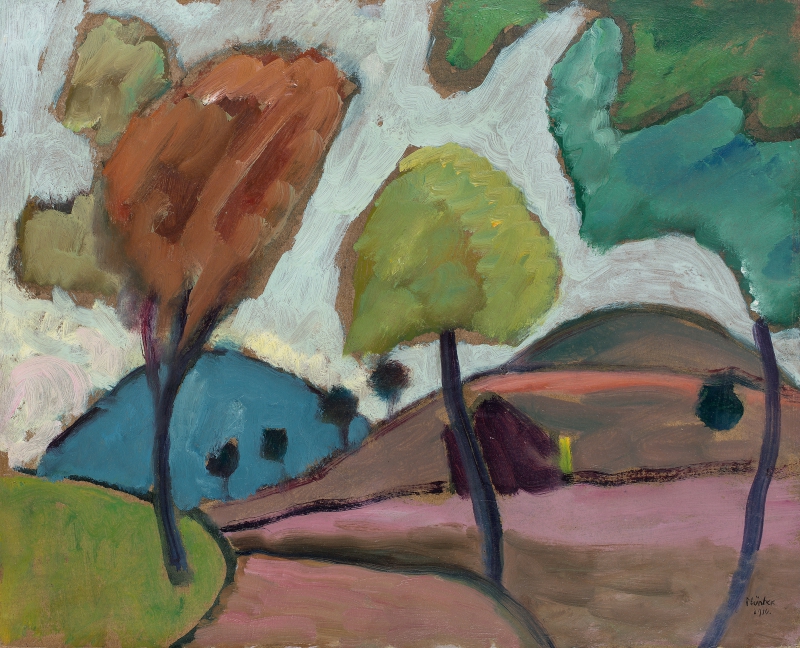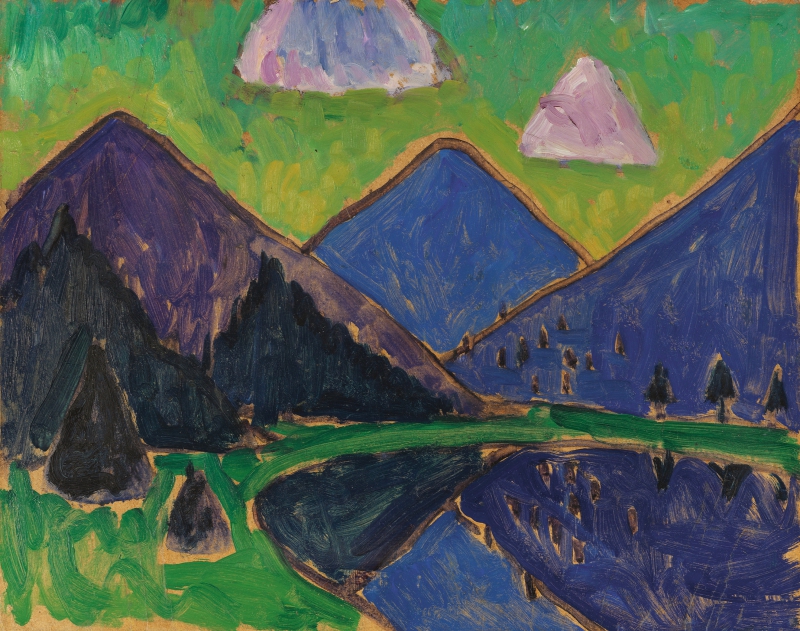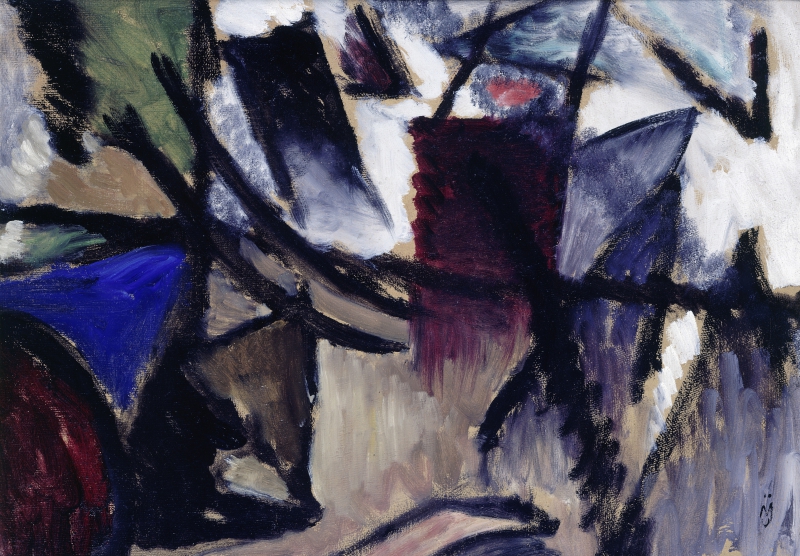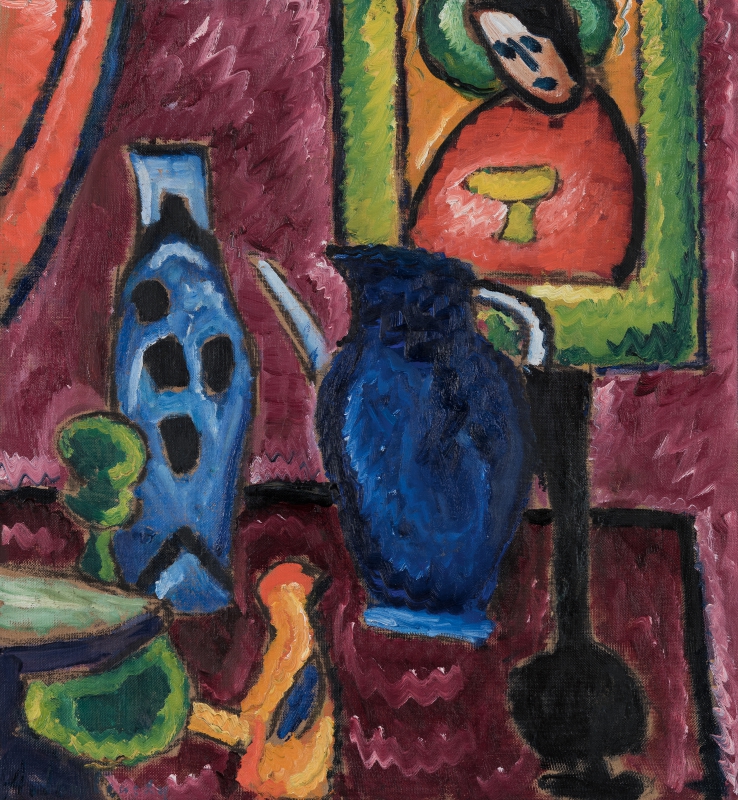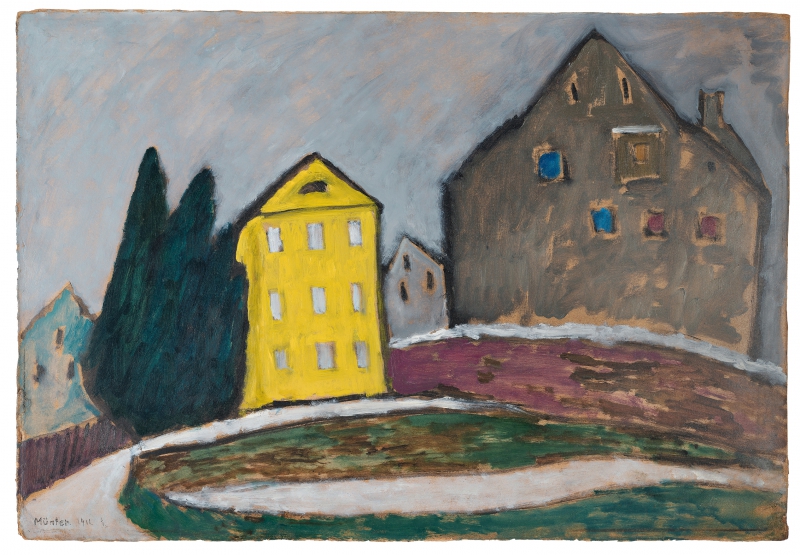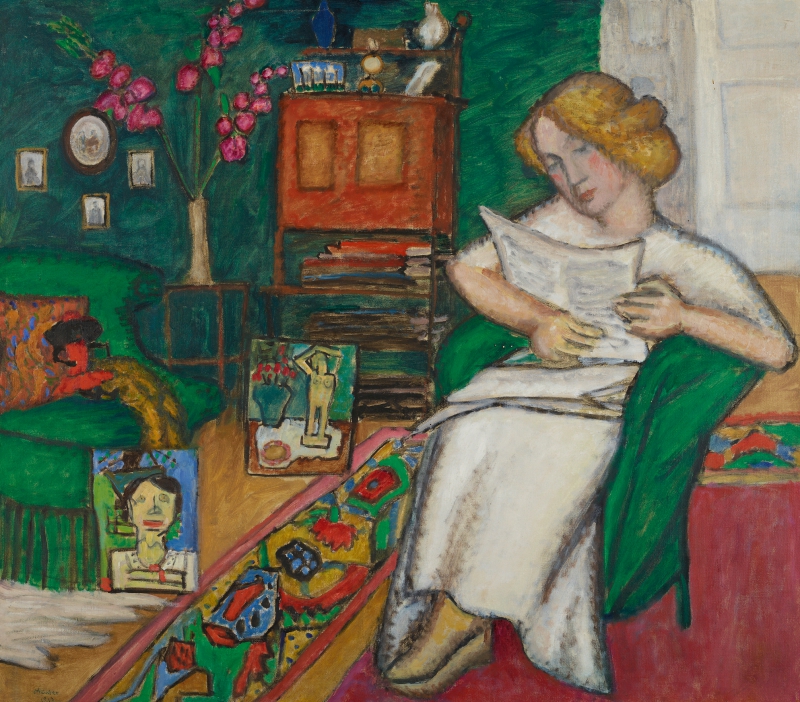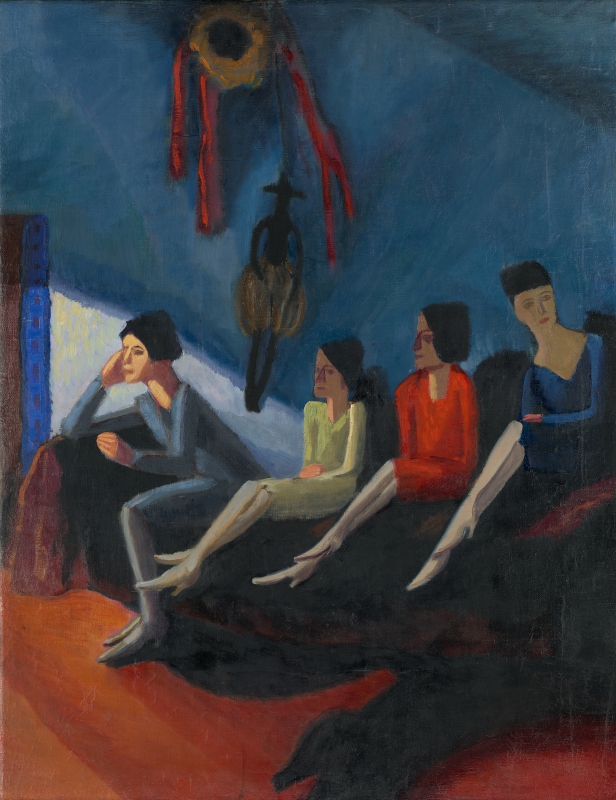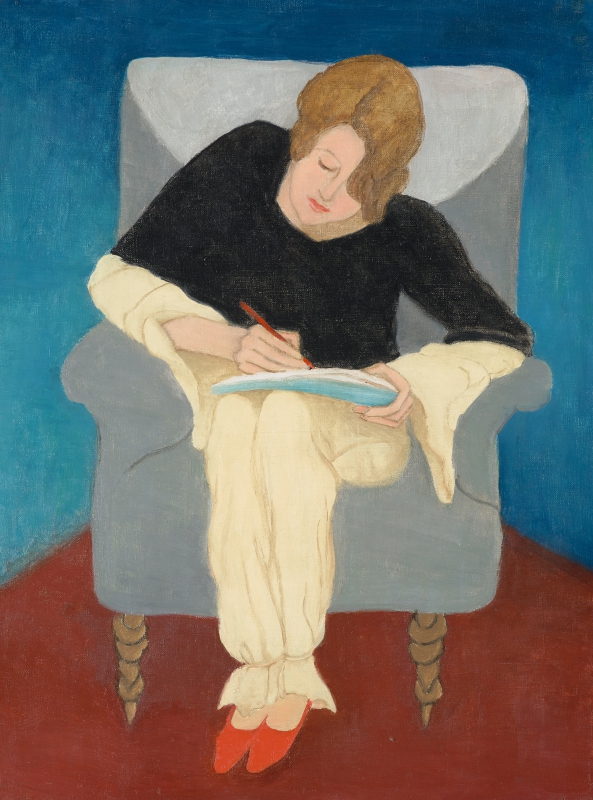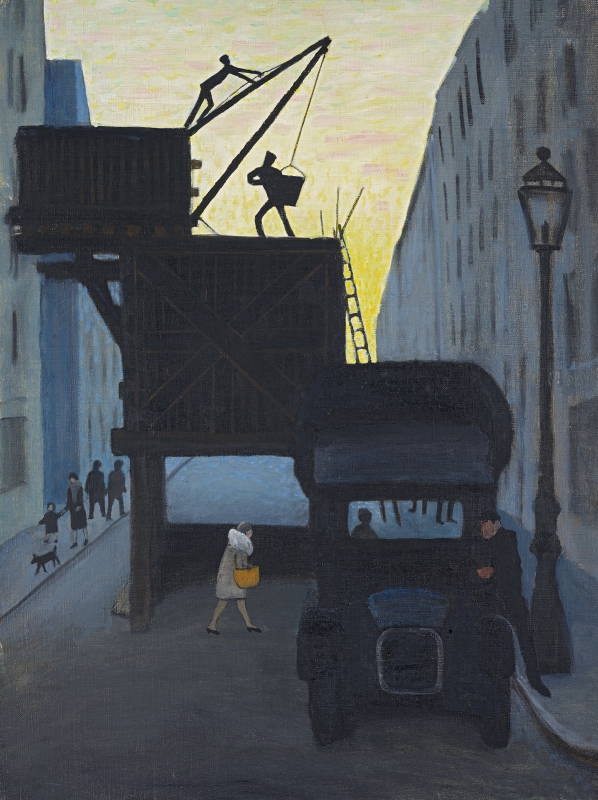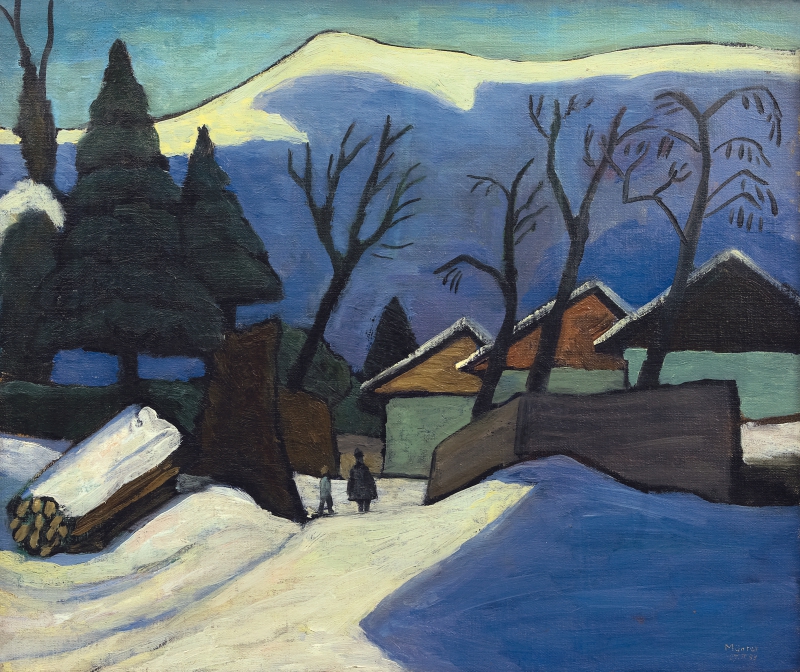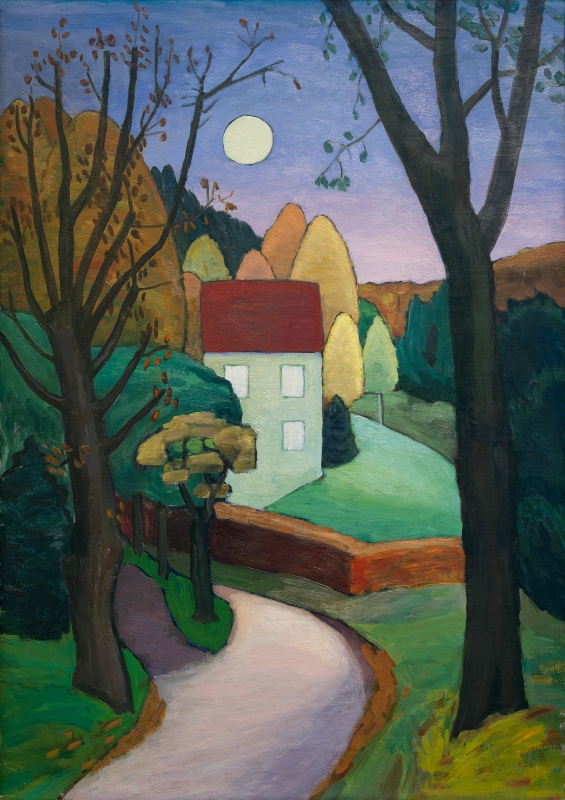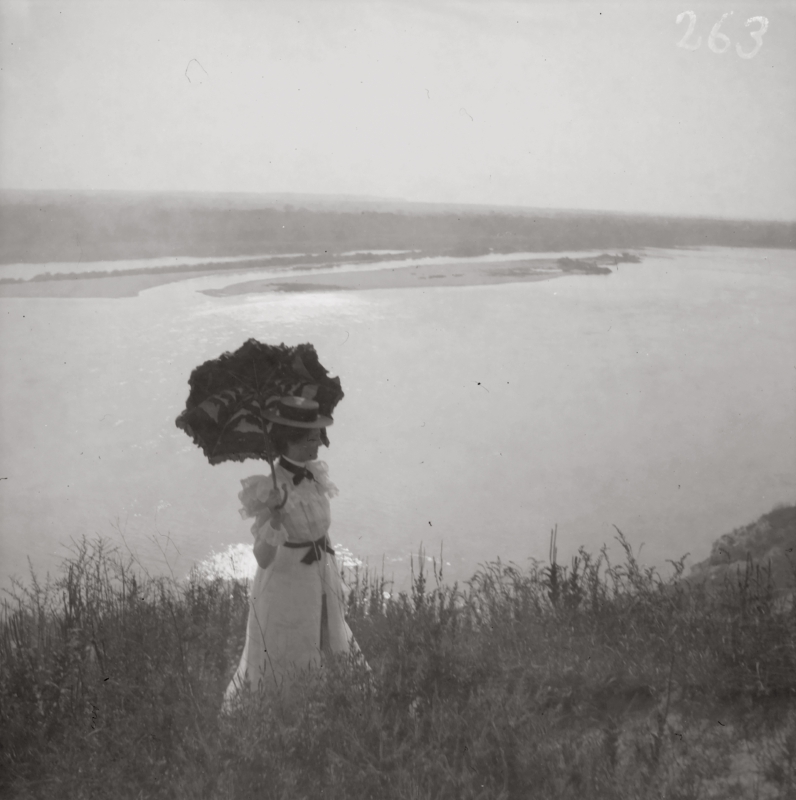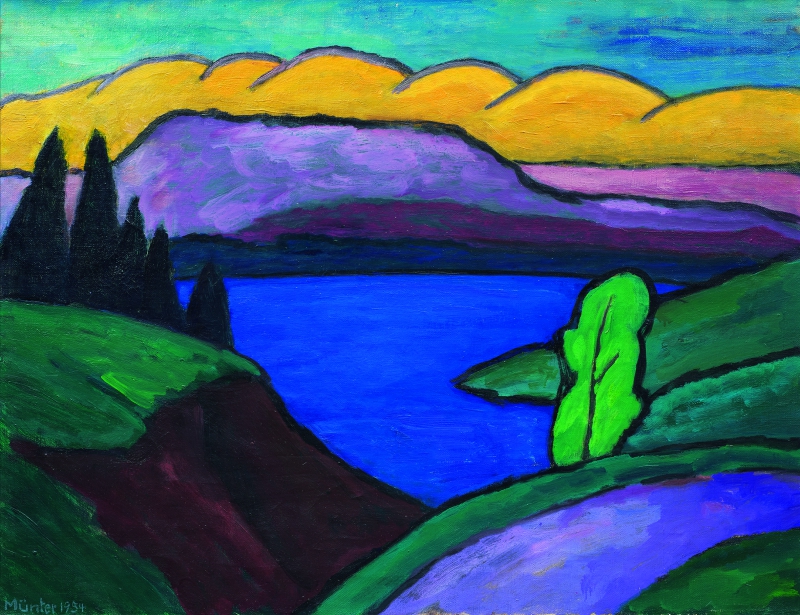Gabriele Münter (1877–1962) was much more than just “the woman by Kandinsky’s side”. Thanks to exhibitions and publications on her oeuvre, especially throughout the past two decades, she has earned wide recognition as one of the leading protagonists of the German avant-garde. Now, the Leopold Museum is the first institution in Austria to dedicate a comprehensive solo exhibition to her work. Divided into twelve thematic emphases, the exhibition highlights the stages of the Expressionist painter’s life, which often coincided with changes in her style and lively interest in untested techniques and subjects.
Around 140 exhibits from public and private international collections – including oil paintings, printed graphic works, drawings, photographs and artisanal objects – afford profound insights into the artist’s multi-faceted oeuvre.
The Leopold Museum is the first institution in Austria to dedicate a comprehensive exhibition to the work of Gabriele Münter (1877–1962), one of the main exponents of the European avant-garde. Featuring high-quality artworks from international museums and private collections, the exhibition affords insights into the artist’s multi-faceted oeuvre. Münter practiced the most diverse techniques, tried out courageous stylistic changes, and pursued a life-long quest for pure painterly expression. Her path was shaped by enthusiastic moments, occasioned by artistic achievements, but also by personal disappointments and periods of resignation.
Reappraisal of Her Oeuvre
The presentation at the Leopold Museum focuses on the autonomy of Münter’s achievements and illustrates that this exceptional artist was much more than merely the companion of Wassily Kandinsky (1866–1944) who lived in the shadow of the Russian avant-gardist. However, during her lifetime, and long thereafter, she was reduced to this role. Only over the past few decades, trend-setting exhibitions and publications have led to a reappraisal of her oeuvre.
“Today, Gabriele Münter enjoys the status of a stylite of the German avant-garde and international Modernism. Owing to their significant compositional schemes, focused on form, color, simplicity and harmony, some of her paintings have become veritable icons of German Expressionism. That the Leopold Museum is now the first Austrian institution to present a comprehensive Münter retrospective – a dream we have cherished for a decade – fills us with great joy.” Hans-Peter Wipplinger, Director of the Leopold Museum
Photography, Encounter with Kandinsky and Travels
The exhibition starts off with a spotlight on the artist’s photographic oeuvre. During a two-year trip through the US from 1898 to visit her American relatives, she captured the impressions of her travels in unconventional photographs. Upon her return to Germany, Münter studied from 1901 at private schools in Munich, as women were still denied access to state academies at the time. At the art school run by the artists’ group Phalanx, she met Wassily Kandinsky, the association’s president. She created her first oil paintings during the summer courses for plein-air painting run by Kandinsky. At the Upper Bavarian Kochel am See, the student and her married teacher first became close. From 1904 to 1908, they embarked on numerous trips together, including to Holland, Tunisia and France.
Path towards Reduction
The artist’s in-depth study of printing techniques yielded the series of color linoleum cuts Kandinsky (1906), as well as other printed graphic works, which are shown in the exhibition. This reduction of depictions to contours and color fields would soon spill over into her oil paintings.
“Even to the untrained eye, Gabriele Münter’s paintings quickly reveal the draftswoman, as the ‘secret master of clean lines’ (Gustav Friedrich Hartlaub) was, in fact, an entirely obvious one. The type of abstraction which, as we know, does not physically exist, but is ubiquitous in the world of visual things – the line – plays a constituent role in many of Münter’s works – that of a framework.” Ivan Ristić, curator of the exhibition
In the summer of 1908, Münter and Kandinsky discovered the picturesque Upper Bavarian town of Murnau am Staffelsee. It was there that the artist achieved her decisive breakthrough in terms of clarity and reduction. Münter purchased a house on the edge of town, where she hosted the protagonists of avant-garde art, among them Marianne von Werefkin, Alexej von Jawlensky, Franz Marc, August Macke, Paul Klee and Arnold Schönberg. Her Portrait of Marianne von Werefkin, an icon of Modernism created in front of the house in Murnau, and the painting Portrait of a Young Lady with Large Hat (Polish Woman), both painted in 1909, feature in the exhibition in central positions.
Münter was one of the co-founders of the artists’ association Neue Künstlervereinigung München [New Artists’ Association Munich] (N.K.V.M.) in 1909. She acted as the group’s promoter, and also decisively shaped the project of Der Blaue Reiter. Documenting these projects in photographs, she became the most important chronicler of the Munich avant-garde. The Berlin gallery owner Herwarth Walden, a key figure of the German art scene, organized a comprehensive solo exhibition dedicated to Gabriele Münter at his gallery Der Sturm in early 1913.
Reverse Glass Painting, Abstraction and Children’s Worlds
Münter shared her fascination for reverse glass painting with Jawlensky who began collecting examples of Upper Bavarian reverse glass painting in 1908. His work Still Life with an Image of a Saint, which features a piece of folkloristic reverse glass painting as a picture within the picture, is presented in the exhibition. Inspiration derived from the reverse glass technique, along with the innovative colors of the Fauvists, helped Münter develop her unmistakable style. From 1912, she focused on the possibilities of abstraction, paraphrasing her own interiors and still lifes. The almanac Der Blaue Reiter, published by Kandinsky and Franz Marc in 1912, featured not only works of “naïve” art but also children’s drawings, including four by Münter’s niece. Examples of these images created by children can be found in the work In the Room (1913) presented in the exhibition. Without sentimentality, Münter looked for design formulas in children’s art.
In 1915, Gabriele Münter left Germany for Sweden. In December, Kandinsky came from Russia to join her in Stockholm, where Münter had organized a solo exhibition of his works. This was followed by a presentation of her own works, after which Kandinsky returned to Russia, ended their relationship for good and left Münter alone and embittered. In late 1917, Münter moved to Copenhagen, where her hitherto largest exhibition was shown in 1918.
Münter returned to Germany in 1920, and subsequently exhibited with the New Munich Secession and at Galerie Thannhauser. This period was shaped by a personal and artistic crisis, and her protracted legal battle with Kandinsky, who demanded the return of the works he had left behind in Munich. In 1927, she first met the art historian Johannes Eichner, who became her second partner. A productive period in Paris and the South of France ensued. From the second half of the 1920s, her works started to reveal influences of New Objectivity. This period in her oeuvre yielded the paintings Listeners (1925-1930) and Lady in an Armchair, Writing (1929) which are both included in the presentation. Changes in the landscape owing to industrialization were reflected in Münter’s paintings, while the artist also depicted the life of workers in an urban context, for instance in the painting Building Crane (1930). From 1931, Münter settled in Murnau once more. In 1936, Johannes Eichner moved from Berlin to the summer house, which the couple now used as a permanent residence. The adjacent flower garden inspired the nuanced colors of Münter’s still lifes. The move marked the artist’s return to her artistic roots and to great productivity.
In July 1937, the National Socialist traveling exhibition Entartete Kunst [Degenerate Art] opened in Munich. Hundreds of works of German and international avant-garde art, seized from public collections, were denounced as decadent and “alien to the race”. Works by Gabriele Münter, who at the time was not represented in any German museums, did not feature in this infamous propaganda exhibition. The artist escaped an employment ban. While she largely managed to avoid hostilities from the regime’s cultural authorities, she was not successful either. Münter’s and Eichner’s house in Murnau, meanwhile, became a safe haven of Modernism: Throughout the time of National Socialist barbarism, the couple hid numerous early works by Kandinsky as well as archival material pertaining to Der Blaue Reiter. In 1957, Gabriele Münter donated over 100 works to the Lenbachhaus, including paintings by herself, Kandinsky and other protagonists of Der Blaue Reiter. While she was celebrated as a benefactor during her lifetime, Gabriele Münter did not live to see the reappraisal of her own oeuvre, which has earned her a place at the forefront of international art.
Curator: Ivan Ristić
Expert consultant: Annegret Hoberg
The exhibition is accompanied by a comprehensive catalogue, available in German and English, published by Ivan Ristić and Hans-Peter Wipplinger, with essays by Barbara Halbmayr, Annegret Hoberg, Gisela Kleine, Angela Lampe, Ivan Ristić and Hans-Peter Wipplinger.
https://www.leopoldmuseum.org/en/press/press-materials/1326/GABRIELE-MUeNTERRetrospective
GABRIELE MÜNTER 1877–1962 Promenade (Promenade on the Seine), 1904–1906 Oil on cardboard | 15.9 × 17.9 cm Kunsthalle Emden Photo: bpk/Kunsthalle Emden/Martinus Ekkenga © Bildrecht, Wien 2023 02 |
GABRIELE MÜNTER 1877–1962 Kandinsky, 1906 Color linocut on paper | 24.4 × 17.7 cm Franz Marc Museum, Kochel am See; long-term loan ahlers collection Photo: ahlers collection/Thomas Ganzenmüller, Hanover © Bildrecht, Wien 2023 03 |
GABRIELE MÜNTER 1877–1962 Portrait of Gustl Blab, c. 1908 Oil on cardboard | 102.5 × 75 cm Private collection, Germany Photo: Karl & Faber Kunstauktionen, Munich © Bildrecht, Wien 2023 04 |
GABRIELE MÜNTER 1877–1962 Portrait of a Young Lady with Large Hat (Polish Woman), 1909 Oil on cardboard | 70 × 50 cm Private Collection. On long-term loan to The Courtauld, London Photo: Private Collection. On long-term loan to The Courtauld, London/Bridgeman Images © Bildrecht, Wien 2023 05 |
GABRIELE MÜNTER 1877–1962 Fruits and Flowers, 1909 Oil on cardboard | 32.5 x 33.5 cm ALBERTINA, Vienna - The Batliner Collection Photo: ALBERTINA, Vienna - The Batliner Collection © Bildrecht, Wien 2023 06 |
GABRIELE MÜNTER 1877–1962 Portrait Marianne von Werefkin, 1909 Oil on cardboard | 81 × 55 cm Städtische Galerie im Lenbachhaus und Kunstbau München Photo: Städtische Galerie im Lenbachhaus und Kunstbau München, Gabriele Münter Stiftung 1957 © Bildrecht, Wien 2023 07 |
GABRIELE MÜNTER 1877–1962 Listening (Portrait of Jawlensky), 1909 Oil on cardboard | 49.8 × 66.4 cm Städtische Galerie im Lenbachhaus und Kunstbau München Photo: Städtische Galerie im Lenbachhaus und Kunstbau München, Gabriele Münter Stiftung 1957 © Bildrecht, Wien 2023| 3 08 |
GABRIELE MÜNTER 1877–1962 Straight Road, 1910 Oil on cardboard | 40.5 × 33 cm Collection Selinka, Kunstmuseum Ravensburg Photo: Sammlung Selinka, Kunstmuseum Ravensburg/Wynrich Zlomke © Bildrecht, Wien 2023 09 |
GABRIELE MÜNTER 1877–1962 Autumnal Country Road, 1910 Oil on cardboard | 32.7 × 40.7 cm Private collection Photo: Grisebach GmbH, Berlin © Bildrecht, Wien 2023 10 |
GABRIELE MÜNTER 1877–1962 View of the Murnauer Moos (Blue Mountains), c. 1910 Oil on cardboard | 32.5 × 40.5 Private collection, Germany Photo: Ketterer Kunst GmbH und Co. KG © Bildrecht, Wien 2023 12 |
GABRIELE MÜNTER 1877–1962 Abstraction, 1912 Oil on cardboard | 50 × 71 cm Staatliche Museen zu Berlin, Nationalgalerie. Acquired by the State of Berlin in 1955 Photo: bpk/Nationalgalerie, SMB/Jörg P. Anders © Bildrecht, Wien 2023 13 |
ALEXEJ VON JAWLENSKY 1864–1941 Still Life with an Image of a Saint, c. 1912 Oil on cardboard | 53.3 × 49.3 cm Museum Wiesbaden, long-term loan of the Verein zur Förderung der bildenden Kunst in Wiesbaden e.V. Photo: Museum Wiesbaden/Bernd Fickert 11 |
GABRIELE MÜNTER 1877–1962 Das gelbe Haus, 1911 Öl auf Karton | 51,8 × 75 cm Bayerische Staatsgemäldesammlungen, München, Pinakothek der Moderne Foto: bpk/Bayerische Staatsgemäldesammlungen © Bildrecht, Wien 2023 11 |
GABRIELE MÜNTER 1877–1962 The Yellow House, 1911 Oil on cardboard | 51.8 × 75 cm Bayerische Staatsgemäldesammlungen, München, Pinakothek der Moderne Photo: bpk/Bayerische Staatsgemäldesammlungen © Bildrecht, Wien 2023 14 |
GABRIELE MÜNTER 1877–1962 Im Zimmer, 1913 Öl auf Leinwand | 88,1 × 99,8 cm Städtische Galerie im Lenbachhaus und Kunstbau München, erworben mit Unterstützung der Ernst von Siemens Kunststiftung Foto: Städtische Galerie im Lenbachhaus und Kunstbau München, Gabriele Münter Stiftung 1957 © Bildrecht, Wien 2023 14 |
GABRIELE MÜNTER 1877–1962 In the Room, 1913 Oil on canvas | 88.1 × 99.8 cm Städtische Galerie im Lenbachhaus und Kunstbau München, acquired with the support of the Ernst von Siemens Art Foundation Photo: Städtische Galerie im Lenbachhaus und Kunstbau München, Gabriele Münter Stiftung 1957 © Bildrecht, Wien 2023| 4 15 |
GABRIELE MÜNTER 1877–1962 Sinnende, 1917 Öl auf Leinwand | 66 × 99,5 cm Städtische Galerie im Lenbachhaus und Kunstbau München Foto: Städtische Galerie im Lenbachhaus und Kunstbau München, Gabriele Münter Stiftung 1957 © Bildrecht, Wien 2023 15 |
GABRIELE MÜNTER 1877–1962 Woman in Thought, 1917 Oil on canvas | 66 × 99.5 cm Städtische Galerie im Lenbachhaus und Kunstbau München Photo: Städtische Galerie im Lenbachhaus und Kunstbau München, Gabriele Münter Stiftung 1957 © Bildrecht, Wien 2023 16 |
GABRIELE MÜNTER 1877–1962 Zuhörerinnen, 1925–1930 Öl auf Leinwand | 69,2 × 54 cm Gabriele Münter- und Johannes Eichner-Stiftung, München Foto: Gabriele Münter- und Johannes Eichner-Stiftung, München © Bildrecht, Wien 2023 16 |
GABRIELE MÜNTER 1877–1962 Listeners, 1925–1930 Oil on canvas | 69.2 × 54 cm Gabriele Münter- and Johannes Eichner Foundation, Munich Photo: Gabriele Münter- und Johannes Eichner-Stiftung, Munich © Bildrecht, Wien 2023 17 |
GABRIELE MÜNTER 1877–1962 Lady in an Armchair, Writing, 1929 Oil on canvas | 61.5 × 46.2 cm Gabriele Münter and Johannes Eichner Foundation, Munich Photo: Gabriele Münter- und Johannes Eichner-Stiftung, Munich © Bildrecht, Wien 2023 18 |
GABRIELE MÜNTER 1877–1962 Building Crane, 1930 Oil on canvas | 61.2 × 46.6 cm Gabriele Münter and Johannes Eichner Foundation, Munich Photo: Gabriele Münter- und Johannes Eichner-Stiftung, Munich © Bildrecht, Wien 2023 19 |
GABRIELE MÜNTER 1877–1962 Three Houses in the Snow, 1933 Oil on canvas | 47 × 55.5 cm Kunsthalle Bielefeld Photo: Ingo Bustorf © Bildrecht, Wien 2023 20 |
GABRIELE MÜNTER 1877–1962 Evening Landscape with White Moon (Rising Moon), 1940 Oil on canvas | 85.4 × 60.5 cm Museum Wiesbaden, donation W. and M. Rick 2013 Photo: Museum Wiesbaden/Bernd Fickert © Bildrecht, Wien 2023| 5 23 |
GABRIELE MÜNTER 1877–1962 Woman with Parasol at the Fluvial Terrace of the Mississippi, near St. Louis, Missouri, 1900 New print. Print on Baryta paper from original celluloid negative | 20.5 × 20.5 cm Gabriele Münter and Johannes Eichner Foundation, Munich Photo: Gabriele Münter- und Johannes Eichner-Stiftung, Munich © Bildrecht, Wien 2023 24 |
GABRIELE MÜNTER 1877–1962 The Blue Lake, 1954 Oil on canvas | 50 × 65 cm Lentos Kunstmuseum, Linz Photo: LENTOS Kunstmuseum Linz/Reinhard Haider © Bildrecht, Wien 2023
